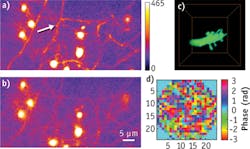MULTIPHOTON IMAGING/SPECTROSCOPY: Iterative, nonlinear approach images noninvasively through intact skull
A major limitation of optical measurement in biological tissue is that imaging depth is limited by aberration and light scattering. Adaptive optics (AO) and other methods can help to overcome these factors, but impose their own limitations. To meet these challenges, Meng Cui and Lingie Kong of Howard Hughes Medical Institute's Janelia Research Campus have developed an iterative multiphoton adaptive compensation technique (IMPACT), which uses iterative feedback and nonlinearity to quickly measure wavefront in a highly scattering environment.1
A new paper reports recent progress of applying IMPACT to functional imaging of the cortex to ~660 μm, through the intact skull, in awake mice. In experiments, the technique's high-speed operation (the wavefront can be updated at ~8 kHz and beating frequency is distributed between 2 and 4 kHz) were shown to work well for imaging awake, head-restrained animals, which is challenging for AO. IMPACT compensates wavefront distortion with a large number of spatial modes and does not require taking multiple images; instead, IMPACT maximizes nonlinear (second, third, and higher order) signals, which derives from the laser focus. But laser power during is similar to the actual imaging power, and experiments on GFP- and YFP-expressing samples showed no photobleaching or phototoxicity.
Although the paper mainly discusses imaging applications, the researchers report that IMPACT can also be used for spectroscopy applications to achieve greater signal-to-noise ratio or shorten the measurement time.
1. L. Kong and M. Cui, Opt. Exp., 22, 20, 23786–23794 (2014); doi:10.1364/OE.22.023786.
